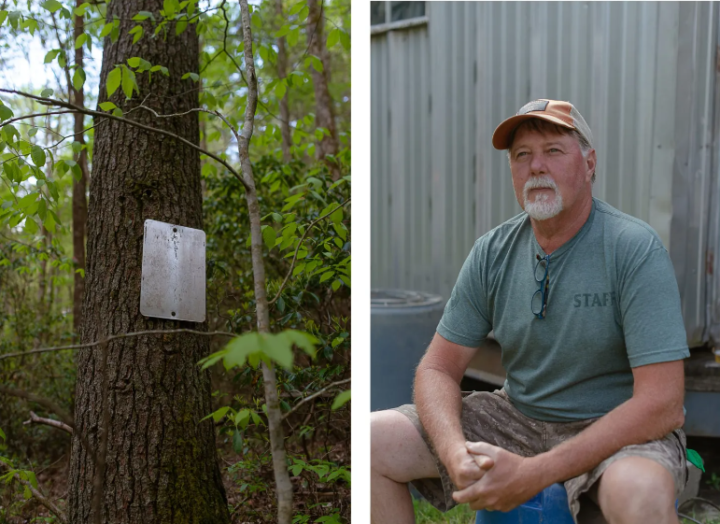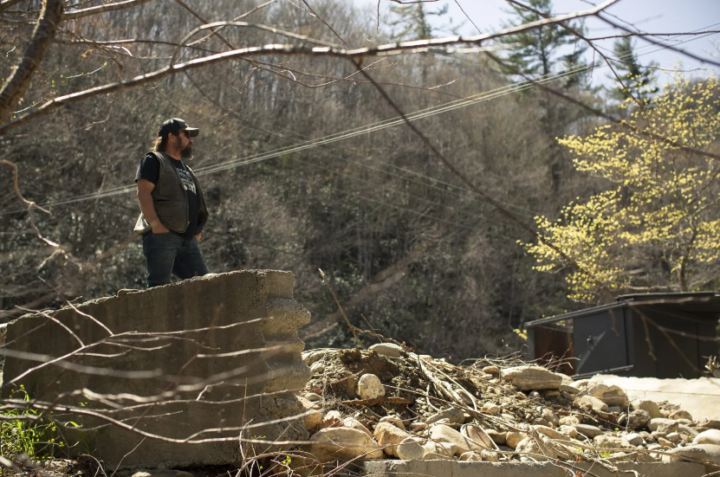By Jack Igelman, originally published by Carolina Public Press. Carolina Public Press is an independent, in-depth and investigative nonprofit news service for North Carolina.
This is a two-part investigative project reported by Jack Igelman. The project tells the history of the North Fork, how conservationists have long advocated for its special federal protection, and the process to achieve wild and scenic status for its preservation. This is part one of the investigation.
As it winds its way through rugged landscapes, diverse ecosystems, and cherished recreational areas, the French Broad River in Western North Carolina is believed to be one of the oldest rivers in the world. Paddlers, conservationists, and other river enthusiasts have long advocated for special federal protection for one of its most beloved tributaries in Transylvania County.
But achieving the coveted designation for the North Fork of the French Broad and similar rivers is like navigating a challenging whitewater stream. It involves skillfully maneuvering through government bureaucracy, adding years of study and review to the designation process. This complex and prolonged process requires support from local government, legislation enacted by Congress and the president’s signature.
Harrison Metzger of Mills River in Henderson County is perhaps one of the North Fork’s fiercest advocates and is supporting the effort in neighboring Transylvania County to gain federal protection for this whitewater paddling destination within Pisgah National Forest. Not only has he paddled the river dozens of times, but as a local journalist in the late 1980s and early 1990s for the Hendersonville Times-News, he reported on the thwarted effort to dam the North Fork and five other tributaries of the French Broad River.
Metzger calls the North Fork a “hidden treasure” and views it as a highly accessible creek run in Western North Carolina, treasured for its tight and steep features by whitewater boaters, especially during and after heavy rainfall.
Supporters like Metzger have helped generate enthusiasm and support for federal wild and scenic status to preserve the North Fork’s natural state. Yet others are concerned about additional federal protections they see as unnecessary and intrusive. Even though the North Fork has been deemed eligible for wild and scenic status, attaining that designation isn’t certain.
Despite the challenges of achieving wild and scenic river status, a portion of the French Broad has made the cut of eligible rivers. That’s just the first step, though, in the lengthy process to protect it.
The French Broad and its importance
Wilma Dykeman‘s nonfiction book “The French Broad,” published in 1955, has captured the affection of many, including local business owner David Whitmire, who was presented with a signed copy in 1992 as an acknowledgment of his river stewardship.

He and his wife, Debi, started Headwaters Outfitters in Rosman’s downtown in 1992. Later that year, they moved their business to its present spot by the French Broad River, where the North Fork and West Fork meet. It’s a quiet spot for paddling and fishing near the edge of Pisgah National Forest.
Dykeman’s book was both an ode to the river and a profile of the French Broad River’s fragile condition, which became a catalyst for the ecological renewal of the river. Her book made the case that the polluted river should be cleaned, years before the national environmental movement took hold. “Dwellers of the French Broad country are learning an ancient lesson in all their resources: it is easy to destroy…,” she wrote in the book’s introduction. “Because the river belongs to everyone, it is the possession of no one. And as towns and villages grew, they dumped their trash. Filth is the price we pay for apathy.”
Whitmire, 63, is tall and sturdy with a white goatee, and he has spent much of his life on or near the French Broad. He agrees with Dykeman’s view that the river wasn’t well cared for in the past.
“The river was just how you got rid of things. You’d throw it over the bank, and it would disappear,” says Whitmire. “For years, that’s how it was.”
As a boy, he recalled trips down the river in an aluminum canoe, fishing for muskie and trout. “I learned to canoe and really appreciate the river,” he said.
Since then, the Whitmires have led efforts to care for the river and helped grow a tourism industry. Now, thousands of people come to paddle and fish the river in Transylvania County.
“They’ve just done a beautiful job of drawing attention to the river,” observed Metzger.
The North Fork is a section of the river that has special meaning to Whitmire. What really “touched my soul,” Whitmire recently told me, was when he paddled the North Fork for the first time in the late 1980s.
“There was something about running that section. It’s just one of those special places, and it doesn’t ever need to be changed,” he said.
During Whitmire’s lifetime, however, the North Fork narrowly dodged two forceful efforts by the federal government to alter its flow. The first was from the Tennessee Valley Authority in 1966, and the second attempt was in 1988.
Big dam era
Free-flowing water is a key characteristic for wild and scenic status. Flood control dams, of course, would disrupt the river’s natural state.
Congress passed the Wild and Scenic Rivers Act in 1968 because there were too many dam-building and river-diversion projects happening across the country for decades. The purpose of the legislation was to create a system “to preserve certain rivers with outstanding natural, cultural and recreation values in a free-flowing condition.”
The geographical and climatic properties of the North Fork of the French Broad’s gorge make it an ideal candidate for building a dam to generate power and control downstream flooding. For many years, proposals have been suggested to build dams on the French Broad’s headwater streams to prevent floods, protect property and save lives. But in every case, these dam plans were stopped or abandoned.
In 1966, the Tennessee Valley Authority promised to build dams on 14 tributaries of the French Broad, including the North Fork, which flows into the Tennessee River. But a strong local fight forced the federal agency to drop its plans.
Two decades later, however, a program to dam the North Fork and five other tributaries in the French Broad’s headwaters was again proposed, this time by the U.S Department of Agriculture’s Soil Conservation Service (now the Natural Resources Conservation Service).
At the time, Metzger had just been appointed as the Brevard bureau chief of the Hendersonville Times-News. This past spring, Metzger provided CPP with a thick manila folder with clips of his reporting on the proposal and resistance to damming the rivers.
“I really tried to be fair to all sides. I was a reporter, and I was doing my job. I was talking to people on both sides of the issue,” he said, acknowledging that he moved to the area in the 1980s because he was a paddler interested in the region’s abundant whitewater. Metzger is now a writer for magazines and a public relations firm.
In 1984, Transylvania County asked the agency to find ways to protect against flooding. A study of the Upper French Broad River Floodplain Project was done in 1988, and in August 1989, a public meeting was held to discuss concerns and issues. At the meeting, the agency presented an early cost estimate for building six dams, each costing around $16 million to $18 million. The upcoming proposal would later include a plan for a 56-foot-high dam that would create a 53-acre reservoir on the North Fork.
The dam on the North Fork would flood portions of Pisgah National Forest, and 700 acres of private property would be condemned to accommodate the structure and reservoir, according to the government study.
Soon, an opposition group formed—the French Broad Headwaters Coalition, or FBHC—that included sportsmen, whitewater boaters and a range of organizations, including Trout Unlimited and the Transylvania County League of Women Voters. Another group, the Transylvania Headwaters Defense Association, also formed and described itself as an unlikely coalition of natives, longtime transplants and newcomers, each opposed to building dams in the flood plain.
Among the members of the FBHC was Whitmire of Headwaters Outfitters, who was raised in the unincorporated Transylvania County community of Quebec. As quoted in March 1991, Whitmire said that “damming could cause dramatic loss of water quality and habitat along the river. Free-flowing river is what we’re interested in.”
Some residents of Rosman, however, Metzger reported, favored the project to alleviate frequent flooding, prevent property damage and loss of life in the event of a major flood. In his reporting, Metzger quoted Brenda Morgan of the Rosman Board of Alderman, who recounted how she had to evacuate children from her home more than 20 times. “My first concern is with lives. I think they should take precedent [sic]. They are more important than protecting different types of trees, leaves and ferns.”
Many in the community, both experts and residents, felt an urgency to prevent destruction from future flooding.
“People are getting frustrated because the river has absolutely been studied to death. We all know it floods and we even can tell you how deep it will flood the buildings. The question now posed to the sponsors is, what are we going to do about it?” asked the Soil Conservation Service’s district conservationist, Bob Twomey, in a Jan. 24, 1993, article by Metzger. Twomey did not respond to requests for comment. He is currently an elected supervisor of the Transylvania County Soil and Water Conservation District.
On Feb. 2, 1993, the agency unveiled 12 possible project alternatives in a courtroom crammed with onlookers.
Soon after, on April 19, 1993, the headline in the Times-News was “County Shoots Down Dam Plan.” The Transylvania County Board of Commissioners voted unanimously to pursue a flood protection option that involved flood-proofing structures and improving flood warning systems. The option excluded dams.
Despite the win for advocates of a free-flowing North Fork and because of the region’s propensity to flood, Whitmire and Metzger worry that dam builders may again seek to manage its flow.
Transylvania County reports some of the highest annual rainfall averages in the region—75 inches per year compared with 45 inches in Buncombe County. Due to its proximity to the high peaks of the Great Balsam Mountains and its steep watershed, the town of Rosman is particularly prone to floods
“You’ve got this situation where all these headwater streams from higher elevations come tumbling out of the mountains and then all converge in the valley near Rosman,” said Metzger.
Periodically, the rains come in large, concentrated bursts, drenching the valley communities downstream.
The worst flood in recorded history overwhelmed the region in the first two weeks of July 1916. Remnants of a Gulf Coast hurricane pounded Western North Carolina, and on July 16, a hurricane from the Atlantic brought an additional inundation of water.
In 1964, between Sept. 28 and 30, some 17 inches of rain walloped Rosman. Days later, on Oct. 4 and 5, another round of intense rainfall pounded the town with 17 more inches.

More recently, on Aug. 17, 2021, Tropical Storm Fred trudged northeast from the Gulf of Mexico and eventually stalled on the Great Balsam Mountains, unleashing a maelstrom of tropical moisture. In a 60-hour period, the result of the deluge had enormous consequences, including six lost lives in the Cruso community in Haywood County. In Rosman, whose main street runs along the French Broad below the confluence of the North and West forks, the river reached its second-highest crest on record.
The volume of future rainfall totals may also be elevated by climate change.
In 2021, David Easterling, chief of the Scientific Services Division at the National Oceanic and Atmospheric Administration’s National Centers for Environmental Information in Asheville, told Carolina Public Press that the high elevations and ridge tops of the mountains receive the most rain from the remnants of tropical storms and hurricanes.
“My expectation, based on the science, is that climate change made Fred more intense by an order of 2 or 3 additional inches,” he said. Easterling is a co-author of the N.C. Climate Science Report released in March 2020.
“That’s speculation, of course, but the expectation in the future is that when storms occur, they will be more intense in terms of rainfall due to a warmer atmosphere,” he said. “As the atmosphere warms, it can hold more moisture, so when they do occur, they will be more powerful and lead to more frequent and stronger flash floods.”




Before you comment
The comments section is here to provide a platform for civil dialogue on the issues we face together as a local community. Xpress is committed to offering this platform for all voices, but when the tone of the discussion gets nasty or strays off topic, we believe many people choose not to participate. Xpress editors are determined to moderate comments to ensure a constructive interchange is maintained. All comments judged not to be in keeping with the spirit of civil discourse will be removed and repeat violators will be banned. See here for our terms of service. Thank you for being part of this effort to promote respectful discussion.